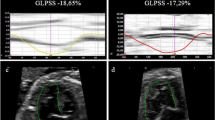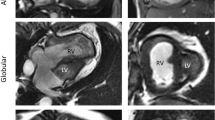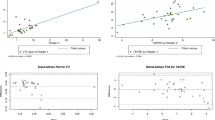Abstract
The presence of a genetic condition is a risk factor for increased mortality in hypoplastic left heart syndrome (HLHS). Speckle tracking strain analysis in interstage echocardiograms have shown promise in identifying patients with HLHS at increased risk of mortality. We hypothesized that fetuses with a genetic condition and HLHS have impaired right ventricular global longitudinal strain compared with fetuses with HLHS and no evident genetic condition. We performed a retrospective analysis of 60 patients diagnosed in fetal life with HLHS from 11/2015 to 11/2019. We evaluated presenting echocardiograms and calculated right ventricular global longitudinal strain (RV GLS) and fractional area of change (FAC) using post-processing software. We first compared RV GLS and FAC between those with genetic conditions to those without. We examined the secondary outcome of mortality among those with and without genetic conditions and among HLHS subgroups. Of the 60 patients with available genetic testing, 11 (18%) had an identified genetic condition. Neither RV GLS nor FAC was significantly different between patients with and without genetic conditions. There was no difference in RV GLS or FAC among HLHS phenotype or those who died or survived as infants. However, patients with a genetic syndrome had increased neonatal and overall mortality. In this cohort, RV GLS did not differ between those with and without a genetic diagnosis, among HLHS phenotypes, or between those surviving and dying as infants. Further analysis of strain throughout gestation and after birth could provide insight into the developing heart in fetuses with HLHS.



Similar content being viewed by others
Abbreviations
- AA:
-
Aortic atresia
- AS:
-
Aortic stenosis
- CHD:
-
Congenital heart disease
- CMA:
-
Chromosomal microarray
- DICOM:
-
Digital Imaging and Communications in Medicine
- FAC:
-
Fractional area of change
- FISH:
-
Fluorescence in situ hybridization
- FPS:
-
Frames per second
- GA:
-
Gestational age
- GLS:
-
Right ventricle global longitudinal strain
- HLHS:
-
Hypoplastic left heart syndrome
- LV:
-
Left ventricle
- MA:
-
Mitral atresia
- Mb:
-
Megabase
- MS:
-
Mitral stenosis
- PI:
-
Pulsatility index
- Q1:
-
Quartile 1
- Q3:
-
Quartile 3
- RV:
-
Right ventricle
- S/D:
-
Systolic/diastolic
- SPSS:
-
Statistical Package for the Social Sciences
- TR:
-
Tricuspid regurgitation
- VUS:
-
Variance of unknown significance
- WES:
-
Whole exome sequence
- WRS:
-
Wilcoxon rank sum
References
Stasik CN, Goldberg CS, Bove EL et al (2006) Current outcomes and risk factors for the Norwood procedure. J Thorac Cardiovasc Surg 131:412–417. https://doi.org/10.1016/j.jtcvs.2005.09.030
Ghanayem NS, Allen KR, Tabbutt S et al (2012) Interstage mortality after the Norwood procedure: results of the multicenter Single Ventricle Reconstruction trial. J Thorac Cardiovasc Surg 144:896–906. https://doi.org/10.1016/j.jtcvs.2012.05.020
Feinstein JA, Benson DW, Dubin AM et al (2012) Hypoplastic left heart syndrome: current considerations and expectations. J Am Coll Cardiol. https://doi.org/10.1016/j.jacc.2011.09.022
Patel A, Hickey E, Mavroudis C et al (2010) Impact of noncardiac congenital and genetic abnormalities on outcomes in hypoplastic left heart syndrome. Ann Thorac Surg 89:1805–1814. https://doi.org/10.1016/j.athoracsur.2010.02.004
Zakaria D, Tang X, Bhakta R et al (2018) Chromosomal abnormalities affect the surgical outcome in infants with hypoplastic left heart syndrome: a large Cohort analysis. Pediatr Cardiol 39:11–18. https://doi.org/10.1007/s00246-017-1717-3
Lara DA, Ethen MK, Canfield MA et al (2017) A population-based analysis of mortality in patients with Turner syndrome and hypoplastic left heart syndrome using the Texas Birth Defects Registry. Congenit Heart Dis 12:105–112. https://doi.org/10.1111/chd.12413
Tabbutt S, Ghanayem N, Ravishankar C et al (2012) Risk factors for hospital morbidity and mortality after the Norwood procedure: a report from the Pediatric Heart Network Single Ventricle Reconstruction trial. J Thorac Cardiovasc Surg 144:882–895. https://doi.org/10.1016/j.jtcvs.2012.05.019
Colquitt JL, Loar RW, Morris SA et al (2019) Serial strain analysis identifies hypoplastic left heart syndrome infants at risk for cardiac morbidity and mortality: a pilot study. J Am Soc Echocardiogr 32:643–650. https://doi.org/10.1016/j.echo.2019.01.006
Brooks PA, Khoo NS, Mackie AS, Hornberger LK (2012) Right ventricular function in fetal hypoplastic left heart syndrome. J Am Soc Echocardiogr 25:1068–1074. https://doi.org/10.1016/j.echo.2012.06.005
Graupner O, Enzensberger C, Wieg L et al (2016) Evaluation of right ventricular function in fetal hypoplastic left heart syndrome by color tissue Doppler imaging. Ultrasound Obstet Gynecol 47:732–738. https://doi.org/10.1002/uog.14940
Miller TA, Puchalski MD, Weng C, Menon SC (2012) Regional and global myocardial deformation of the fetal right ventricle in hypoplastic left heart syndrome. Prenat Diagn 32:949–953. https://doi.org/10.1002/pd.3939
Ebbing C, Rasmussen S, Kiserud T (2007) Middle cerebral artery blood flow velocities and pulsatility index and the cerebroplacental pulsatility ratio: longitudinal reference ranges and terms for serial measurements. Ultrasound Obstet Gynecol 30:287–296. https://doi.org/10.1002/uog.4088
Enzensberger C, Achterberg F, Graupner O et al (2017) Wall-motion tracking in fetal echocardiography—influence of frame rate on longitudinal strain analysis assessed by two-dimensional speckle tracking. Echocardiography 34:898–905. https://doi.org/10.1111/echo.13542
Koopman LP, Slorach C, Manlhiot C et al (2011) Assessment of myocardial deformation in children using digital imaging and communications in medicine (DICOM) data and vendor independent speckle tracking software. J Am Soc Echocardiogr 24:37–44. https://doi.org/10.1016/j.echo.2010.09.018
Truong UT, Sun HY, Tacy TA (2013) Myocardial deformation in the fetal single ventricle. J Am Soc Echocardiogr 26:57–63. https://doi.org/10.1016/j.echo.2012.10.007
Newburger JW, Sleeper LA, Frommelt PC et al (2014) Transplantation-free survival and interventions at 3 years in the single ventricle reconstruction trial. Circulation 129:2013–2020. https://doi.org/10.1161/CIRCULATIONAHA.113.006191
Conrey R, Tume S, Bonilla-Ramirez C et al (2021) Kabuki-syndrome and congenital heart disease—a twenty-year institutional experience. Congenit Heart Dis 16:171–181. https://doi.org/10.32604/chd.2021.014409
Loscalzo ML, Van PL, Ho VB et al (2005) Association between fetal lymphedema and congenital cardiovascular defects in Turner syndrome. Pediatrics 115:732–735. https://doi.org/10.1542/peds.2004-1369
Funding
No specific support.
Author information
Authors and Affiliations
Contributions
JKW, TTD, SAM, RP, and BYF participated in study design, data acquisition, data analysis and interpretation, and manuscript drafting and revision. LS, MN, CAA, and NAA participated in data acquisition and revision of the manuscript. All authors approved the final manuscript as submitted and agree to be accountable for all aspects of the work.
Corresponding author
Ethics declarations
Conflict of interest
The authors have no conflicts of interest relevant to this article to disclose.
Data Availability
Upon request.
Additional information
Publisher's Note
Springer Nature remains neutral with regard to jurisdictional claims in published maps and institutional affiliations.
Rights and permissions
About this article
Cite this article
Wilkes, J.K., Doan, T.T., Morris, S.A. et al. Right Ventricular Global Longitudinal Strain in Fetuses with Hypoplastic Left Heart Syndrome Does Not Differ Between Those With and Without Genetic Conditions. Pediatr Cardiol 43, 655–664 (2022). https://doi.org/10.1007/s00246-021-02770-3
Received:
Accepted:
Published:
Issue Date:
DOI: https://doi.org/10.1007/s00246-021-02770-3




